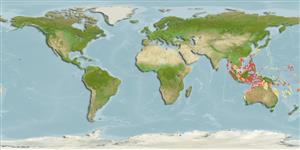>
Ovalentaria/misc (Various families in series Ovalentaria) >
Pseudochromidae (Dottybacks) > Pseudochrominae
Etymology: Pseudochromis: Greek, pseudes = false + Greek, chromis = a fish, perhaps a perch (Ref. 45335); andamanensis: Named for its type locality, Andamen Sea.
Environment: milieu / climate zone / depth range / distribution range
पारिस्थितिकी
समुद्री प्रवाल-भित्ति संयुक्त; गहराई सीमा 1 - 35 m (Ref. 81967). Tropical
Eastern Indian Ocean: eastern Andaman Sea, Indonesia and North West Shelf of Australia.
आकार / वज़न / Age
Maturity: Lm ? range ? - ? cm
Max length : 7.0 cm TL पुल्लिंग / अलिंग; (Ref. 48635)
पृष्ठीय रीढ़ (सम्पूर्ण) : 3; पृष्ठीय सौफट रेज़ (सम्पूर्ण) : 22 - 25; गुदा कांटा: 3; ऐनल सौफट रेज़: 13 - 15. This species distinguished by the following characters: 22-25 (usually 24) segmented dorsal-fin rays; 13-15 (usually 14) segmented anal fin rays; 16 circumpeduncular scales; second anal-fin spine much stouter than the third; a distinct bright yellow to orange stripe or series of spots along the base of the dorsal fin (when preserved pale grey to pale brown) (Ref. 81967).
Inhabits coral areas and is relatively common (Ref. 26137). Also found in coastal, lagoon and exposed seaward reefs (Ref 90102).
Life cycle and mating behavior
परिपक्व अवधि | पुनरुत्पत्ति | मछलीऔ का अंडे देना | अंडे | Fecundity | लार्वा
Lubbock, R., 1980. Five new basslets of the genus Pseudochromis (Teleostei: Pseudochromidae) from the Indo-Australian archipelago. Rev. Suisse Zool. 87(3):821-834. (Ref. 26137)
IUCN Red List Status (Ref. 130435: Version 2024-1)
Threat to humans
Harmless
Human uses
साधन
Special reports
Download XML
इंटरनेट स्रोत
Estimates based on models
Preferred temperature (Ref.
123201): 26.7 - 29.3, mean 28.7 °C (based on 1953 cells).
Phylogenetic diversity index (Ref.
82804): PD
50 = 0.5000 [Uniqueness, from 0.5 = low to 2.0 = high].
Bayesian length-weight: a=0.00501 (0.00193 - 0.01299), b=3.10 (2.88 - 3.32), in cm total length, based on LWR estimates for this (Sub)family-body shape (Ref.
93245).
Trophic level (Ref.
69278): 3.4 ±0.5 se; based on size and trophs of closest relatives
Fishing Vulnerability (Ref.
59153): Low vulnerability (10 of 100).
